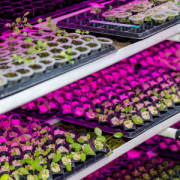AMPLIFY VOL. 36, NO. 3

Agricultural land comprises about a third of total land area worldwide, covering approximately 4.7 billion hectares.1 To meet the demands of a growing global population, agricultural production on this land has intensified over the last few decades, involving fertilizers, chemical pesticides, irrigation, cropland expansion, genetically modified high-yield crops, precision-farming technologies, and more.2
In particular, pesticide use has become more prevalent on croplands, increasing by nearly 50% since the 1990s.3 Despite substantial yield increases through use of agricultural technologies, the impacts of intensification on biodiversity and ecosystem degradation are well documented.4 Excessive use of pesticides has been connected with the contamination of soil and water (both surface and groundwater)5 and the loss of beneficial pest predators such as birds and pollinators.6,7 Sustainable agricultural food production options are essential to mitigate the burgeoning threat of social and environmental instability.
Businesses are beginning to recognize the threats against biodiversity, especially as governments and corporations come under mounting pressure to align with international policies like the United Nations (UN) Global Biodiversity Framework and Sustainable Development Goals (SDGs). Fortunately, there are many ways companies can contribute to biodiversity protection and conservation. For example, biodiversity expert Rajat Panwar and his coauthors offer a corporate biodiversity strategy typology that includes conservation (occurs onsite before biodiversity loss), restoration (occurs onsite after biodiversity loss), compensation (occurs offsite before biodiversity loss), and reparation (occurs offsite after biodiversity loss).8
Given that agriculture affects 11 of the 17 SDGs, there has been a growing call for agricultural business innovations that both provide economic viability and conserve ecosystems (or even restore them).9
Humanity has entered what is often referred to as the fourth agricultural revolution, characterized by the ways technologies from fields like robotics, data science, and genomics have enabled innovative techniques and approaches for increasing food production.10
Among these are technologies enabling indoor crop cultivation. For example, vertical agriculture involves farming in controlled environments without soil, using hydroponic or aeroponic systems and stacked shelves that support crop growth with lighting and nutrient solution systems (see Figure 1). A high-yield, indoor food production method, vertical agriculture has a low environmental footprint and the potential to greatly contribute to biodiversity conservation and restoration.
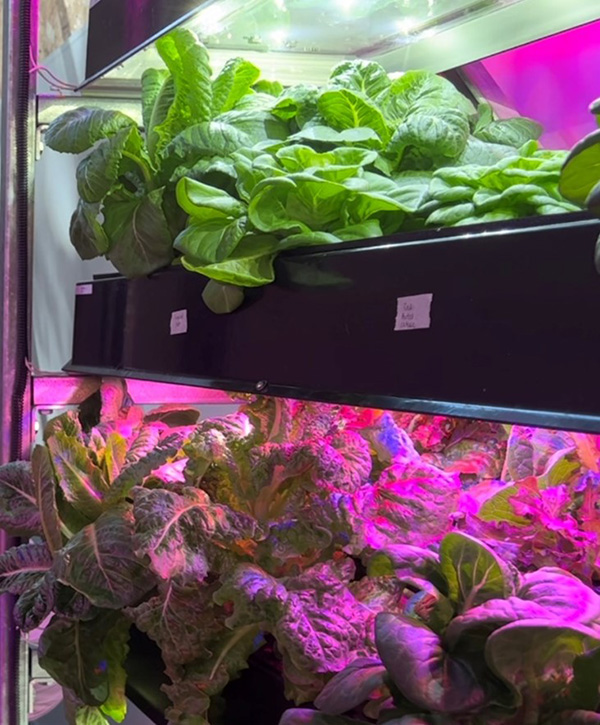
Vertical agriculture can contribute to all four of Panwar et al.’s corporate biodiversity strategies, but it predominantly exists within a conservation approach. Agricultural researchers use a land-sharing and land-sparing framework to understand this paradigm. Land sharing refers to ecologically friendly agriculture; land sparing refers to increasing yields to reduce agricultural expansion into wildlife habitats.11
Vertical agriculture is considered land sparing because it enables large quantities of food to be produced in a variety of small spaces (urban, industrial, commercial, etc.). Vertical agriculture uses no pesticides and much less water and fertilizer inputs than traditional agriculture.12
Land-sparing solutions have the potential to contribute to biodiversity objectives, but there is no guarantee the spared land will result in habitat conservation or ecosystem regeneration. Businesses that wish to invest in food production innovations that support biodiversity conservation must be mindful of several considerations around how vertical farming can meet its potential.13
Food systems are highly interlinked, from production to distribution to consumption, and there are significant social, cultural, economic, environmental, and political factors that interact with those processes.14 Understanding how vertical agriculture fits within these larger food systems is critical to advancing more sustainable food production. This article presents three guiding principles for how vertical agriculture businesses can contribute to biodiversity conservation.
3 Guiding Principles
1. Diversification
The diversification principle is the what aspect of vertical agriculture. That is, what does the vertical farm produce? The principle is derived from a framework proposed by researchers Sarah Rotz and Evan D.G. Fraser. Their framework for social-ecological resilience in food systems suggests that food system resilience is achieved through diversity of components, connectivity between components, and decision-making autonomy within the food system.15
Diversity is integral to resilient ecosystems and economic systems because it allows systems to continue to function in the event that a shock significantly impacts a species population or industry.16 In vertical agriculture, product diversification can contribute to economic resilience and enable access to more markets while increasing its ability to offset the impact of conventional agriculture.
Currently, vertically farmed products are primarily limited to leafy greens (see Figure 2),17 and without diversification, its land-sparing potential will be limited by a lack of ability to engage in this form of production for most crops. Businesses must invest in R&D to increase the types of products offered through vertical agriculture so it can play a significant role in food systems, rather than just being used for novelty products.18 Particularly important is understanding the local markets in which vertical farms exist so they can offer products that align with cultural food preferences and needs.
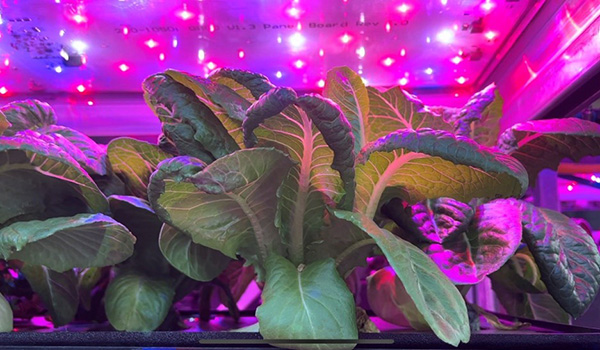
One example is Freight Farms, a Boston, Massachusetts, USA–based company that distributes grow systems for businesses, not-for-profits, and educational institutions. Although Freight Farms specializes in leafy greens, it is among the few vertical agriculture companies with a diversified crop list: more than 20 crops are highlighted as suitable or under experiment for their technology.19
The company has successfully grown multiple varieties of lettuce, greens (kale, chard, bok choy), and herbs and is experimenting with flowers and root vegetables. Freight Farms has diversified the fresh produce offerings at community food centers like Lotus House in Miami, Florida, USA, where the farm grows 15 crops for food-insecure individuals. Diversification is a priority and a challenge for container-farming companies like Freight Farms.
2. Localization
The localization principle is the where aspect of vertical agriculture. That is, where are the vertical farms located? The principle is also derived from Rotz and Fraser’s framework, particularly its connectivity dimension, which captures resilience issues related to the long, vulnerable global supply chains of our conventional food system.
The localization principle centers on the need for decentralized food systems, which shorten supply chains, reduce reliance on imports, and partially address emissions and wildlife impacts from vehicle transport.20 Localization and supply chain considerations also relate to vertical farming inputs like seeds and nutrient solutions. If inputs continue to be sourced through ecologically damaging practices, agricultural impacts are displaced rather than mitigated.21
Localization would ideally support increased fresh food availability in regions that do not have year-round access to locally grown produce, such as urban areas or remote communities. Container-farming companies have risen in prominence in recent years, with the promise to hyper-localize indoor, vertical production of fresh produce in these areas.
For example, Vancouver, Canada–based QuantoTech specializes in modular grow system technologies and vertical agricultural production.22 It has partnerships with numerous remote communities, such as Mackenzie in British Columbia, Canada, with a goal of increasing year-round access to locally produced vegetables. Modular container-farming systems like QuantoTech’s are simple to ship (crucial for remote regions) and scalable in design to support growth and expansion over time.
3. Integration
The integration principle involves the how aspect of vertical agriculture implementation. That is, how is vertical agriculture positioned within the broader food system? Integration is a key component of sustainable, resilient food systems, and an integrated approach allows strategic implementations that align with other sustainability imperatives.23
For example, vertical agriculture’s suitability as an environmental sustainability strategy is compromised by its energy requirement, but integrated approaches can connect vertical farms to distributed energy systems powered by renewable sources.
Integration also refers to connecting to other systems, such as hydroponic-aquaponic systems that provide diversification by adding another product (e.g., fish, seafood). Moreover, integration involves innovations that take a circular economic (CE) approach, in which waste outputs are used as agricultural inputs.24 These practices significantly increase the ability of vertical farming to offset the environmental impacts of the food and agriculture system.
Plant Chicago is a vertical farming company that is firmly integrated within the social, economic, and physical fabric of its city. Formerly a meat-packing plant in Chicago’s industrial area, the facility hosts several small-scale business and educational operations that use one another’s byproducts.25
Plant Chicago began vertical farming and mushroom-growing practices in 2011 and slowly transitioned into an educational space and social enterprise incubator that offers courses on aquaponics, CE, hydroponics, and mycology, as well as small CE business-networking opportunities. Leveraging byproducts from other small businesses, the site is powered in part by an anaerobic digester to offset the costs of powering the farm.26 By implementing CE development priorities into its mission and daily operations, the facility offers diverse products, contributes to multiple sustainability imperatives, and produces food for local distribution.
Applying the 3 Principles: Hypothetical Farms & Business Models
The emerging vertical agriculture industry offers clear opportunities to pursue each of the three principles necessary for achieving biodiversity goals. Several companies are actively diversifying the number and type of crops grown in their production facilities, developing contained grow units for hyper-local production, and planning closed-loop production systems, among other business models.
Regardless of model, these companies are actively contributing to land sparing or conservation and possible biodiversity-related benefits. So far, each of the principles we have discussed has been in isolation. In practice, the business models pursued by companies are likely to intersect to contribute to multiple principles at once (see Figure 3). Below, we describe hypothetical business models that integrate each of the guiding principles for vertical agriculture businesses.
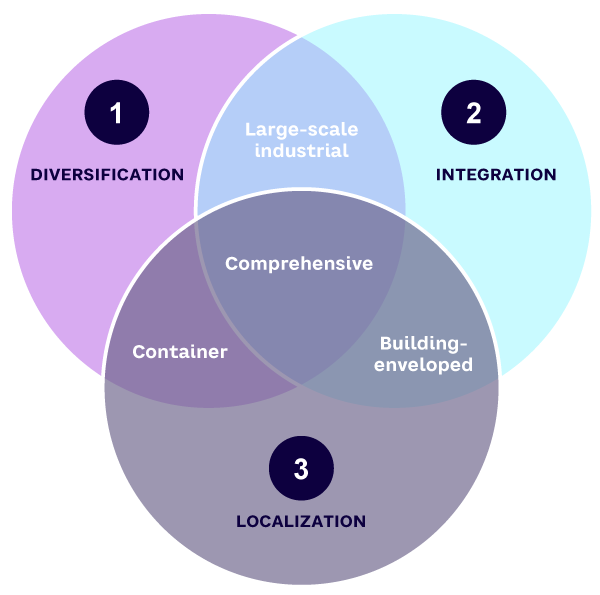
Vertical agriculture operations could be developed in large-scale public or apartment/condominium complexes for hyper-local production of leafy greens (what we term the “building-enveloped model”), catering to those accessing the facility such as students, patients, or residents. This model would contribute to integration and localization, but without increasing product offerings at scale, it may fail to contribute to diversification.
Companies could create contained, standalone grow systems (what we term the “container model”) that can produce diverse food items, including fish. Such a model would contribute to diversification and localization but may fail to contribute to integration.
Companies could develop large-scale industrial grow systems for one or a few crops (what we term “large-scale industrial”) and sell their products in conventional supply chains. Such business models would contribute to diversification and possibly integration but may fail to achieve benefits related to localization.
A comprehensive business model incorporates all three guiding principles. Such a model would produce high volumes of diverse produce for local food systems in addition to collaborating with neighboring industry and businesses to implement CE principles at scale. A summary of this and the other three business models is shown in Table 1.
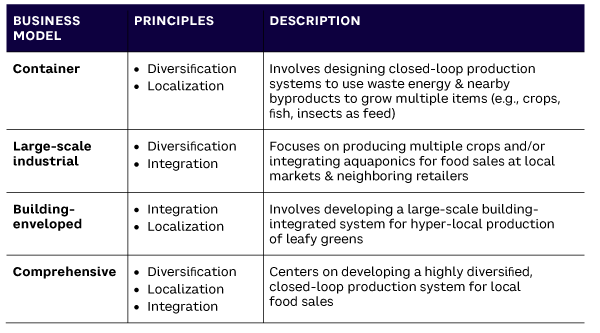
Implementation Considerations
Practical & Managerial Implications
A myriad of research and pilot projects demonstrate how vertical farming can play a critical role in promoting sustainability and improving business profitability.27 As discussed, vertical agriculture is gaining popularity as an innovative approach that produces a consistent supply of locally produced, high-quality, fresh fruits and vegetables with low environmental impact.
Careful control of heating, ventilation, air-conditioning, light and water usage, nutrient availability, and other variables allows for a more consistent supply of uniform, high-quality produce at higher yields and with more efficient resource usage. Furthermore, local food production would reduce transport distance and enhance product shelf life, resulting in lower food waste. In cities where land or space is expensive, high-rises and vacant, older properties, including derelict industrial or commercial buildings, could be repurposed into vertical farms, increasing the supply of fresh, healthy food and creating more local jobs.
However, vertical farming carries a range of risks and barriers associated with high start-up costs from high real estate prices, lack of investment capital, limited variety and quantity of products, and a relatively long time to break even. These factors influence how businesses can scale up to ensure economic viability and a sustained ROI.
Many vertical farms form cross-sector partnerships with venture capitalists, retailers, manufacturers, government, research institutes, and universities to overcome upscaling and funding issues. Examples include Plenty, a California, USA–based indoor vertical farm that partnered with Walmart and three financial investors to help it achieve economies of scale.28
Favorable government policies and institutional endorsement of the technology as integral to food security would boost vertical farming’s visibility and help it achieve wider acceptance. Interdisciplinary research involving practitioners from robotics, engineering, biotechnology, construction, government, and academic institutions could document the specific benefits and shortcomings of various vertical agriculture business models. Such collaborations could also explore complementary technologies that would improve both the business viability and the environmental sustainability of vertical agriculture.
Complementary Technologies
As an emerging food production method, a number of complementary technologies and innovations could enhance vertical farming’s ability to meet the three principles presented and improve its environmental benefits.
For example, blockchain’s traceability features could be used to pursue the localization principle, helping identify and track products within value and supply chains. Blockchain can improve transparency in food systems by providing businesses with opportunities to demonstrate to customers how local their products are and from where they source their farming inputs.29
Such opportunities can be economically beneficial; in a recent survey study on perceptions of vertical farming in British Columbia, most respondents had a favorable view of this form of agriculture and said they would be willing to pay more for vertically farmed products.30
Other technologies that could enhance vertical agriculture include artificial intelligence, robotics, big data analytics, and genomics, which could help increase crop yield and production efficiencies.31 For instance, techniques in functional genomics can be used to identify the best matches for lighting and crop varieties. There are two reasons such efficiencies enhance the biodiversity conservation value and environmental sustainability of vertical agriculture. First, improving yields in smaller spaces (theoretically) improves its land-sparing potential, what is referred to as “sustainable intensification.”32 Second, increasing the efficiency of the system serves to (in part) address the energy consumption issues associated with vertical agriculture.
As an indoor, technology-driven farming approach, vertical agriculture can result in higher greenhouse gas emissions compared to conventional agriculture, depending on the efficiency of the systems and energy sources. Since climate change is inextricably connected with the biodiversity crisis, it is important that vertical agriculture explores and implements complementary technologies to reduce its carbon footprint.
Policy & Collaboration
As a new technology, vertical agriculture requires some policy amendments to thrive. For instance, at the macro scale, subsidies such as those offered in Singapore can help overcome conventional technology lock-in.33 Similarly, land-use designations can be hostile to vertical agriculture because it falls between agricultural and industrial uses. Explicit zoning for vertical agriculture may be necessary, such as the recent amendments to British Columbia’s Agricultural Land Use Regulations and the creation of Quebec’s Zone AgTech.34
Capital expenditure to establish a vertical farm is high, leading to a longer ROI compared to other industry categories and making these farms highly reliant on venture capital. Such economic challenges can be overcome by government subsidies to kickstart the industry; Japan is an excellent example of this sort of thinking.35
Successful integration into the processing and retail chain is a point of weakness for vertical agriculture, but as the industry matures, these challenges are likely to moderate. On a smaller scale, partnerships like the one that led to a co-location of Gotham Greens and a Whole Foods (located in Brooklyn, New York, USA) will continue to be popular and remain an excellent branding exercise.36
Conclusion
Vertical agriculture holds much potential for land sparing and biodiversity conservation, though we note that these tools should be considered a piece of the puzzle in the larger transition to more sustainable, resilient food systems.
On its own, vertical agriculture does not guarantee biodiversity restoration, but it may indirectly contribute to restoration efforts alongside other tools in a land-use management approach. Ultimately, the transition will involve a mix of land-sparing and land-sharing agricultural innovations and solutions.
In this article, we outlined three guiding principles vertical agriculture companies can pursue to achieve the most potential biodiversity-related benefits: (1) diversifying what is being grown; (2) localizing production and sales; and (3) integrating operations with other social, environmental, and economic systems and objectives. A variety of business models in the vertical agriculture industry contribute to these guiding principles to varying and overlapping extents.
We suggest that some combination of all three guiding principles into business models will contribute the most toward potential biodiversity-related benefits through land sparing and conservation. Further research and engagement are necessary to further determine vertical agriculture’s potential contributions to biodiversity beyond land sparing, including restoration, compensation, and reparation.
References
1 “Land Use Statistics and Indicators: Global, Regional and Country Trends — 2000–2020.” FAOSTAT Analytical Brief No. 48, Food and Agriculture Organization (FAO) of the United Nations (UN), 2022.
2 “Agricultural Production Statistics 2000–2021.” FAOSTAT Analytical Brief No. 60, Food and Agriculture Organization (FAO) of the United Nations (UN), 2022.
3 “Pesticides Use, Pesticides Trade and Pesticides Indicators: Global, Regional and Country Trends, 1990–2020.” FAOSTAT Analytical Brief No. 46, Food and Agriculture Organization (FAO) of the United Nations (UN), 2022.
4 Outhwaite, Charlotte L., Peter McCann, and Tim Newbold. “Agriculture and Climate Change Are Reshaping Insect Biodiversity Worldwide.” Nature, Vol. 605, April 2022.
5 “Environmental and Health Impacts of Pesticides and Fertilizers and Ways of Minimizing Them.” United Nations Environment Programme (UNEP), accessed March 2023.
6 Hallmann, Caspar A., et al. “Declines in Insectivorous Birds Are Associated with High Neonicotinoid Concentrations.” Nature, Vol. 511, July 2014.
7 Tosi, Simone, et al. “Lethal, Sublethal, and Combined Effects of Pesticides on Bees: A Meta-Analysis and New Risk Assessment Tools.” Science of The Total Environment, Vol. 844, October 2022.
8 Panwar, Rajat, Holly Ober, and Jonatan Pinkse. “The Uncomfortable Relationship Between Business and Biodiversity: Advancing Research on Business Strategies for Biodiversity Protection.” Business Strategy and the Environment, Special Issue, May 2022.
9 Rahman, Saeed, Natalie Slawinski, and Monika Winn. “How Ecological Knowledge Can Catalyze System-Level Change: Lessons from Agriculture & Beyond.” Amplify, Vol. 1, No. 5, 2022.
10 Klerkx, Laurens, and David Rose. “Dealing with the Game-Changing Technologies of Agriculture 4.0: How Do We Manage Diversity and Responsibility in Food System Transition Pathways?” Global Food Security, Vol. 24, March 2020.
11 Egan, J. Franklin, and David A. Mortensen. “A Comparison of Land-Sharing and Land-Sparing Strategies for Plant Richness Conservation in Agricultural Landscapes.” Ecological Applications, Vol. 22, No. 2, March 2012.
12 Benke, Kurt, and Bruce Tomkins. “Future Food-Production Systems: Vertical Farming and Controlled-Environment Agriculture.” Sustainability: Science, Practice and Policy, Vol. 13, No. 1, November 2017.
13 Jiren, Tolera S., et al. “The Governance of Land Use Strategies: Institutional and Social Dimensions of Land Sparing and Land Sharing.” Conservation Letters, Vol. 11, No. 3, May/June 2018.
14 Ericksen, Polly J. “Conceptualizing Food Systems for Global Environmental Change Research.” Global Environmental Change, Vol. 18, No. 1, February 2008.
15 Rotz, Sarah, and Evan D.G. Fraser. “Resilience and the Industrial Food System: Analyzing the Impacts of Agricultural Industrialization on Food System Vulnerability.” Journal of Environmental Studies and Sciences, Vol. 5, 2015.
16 Berkes, Fikret, and Helen Ross. “Community Resilience: Toward an Integrated Approach.” Society & Natural Resources, Vol. 26, No. 1, 2013.
17 Glaros, Alesandros, et al. “Horizon Scanning and Review of the Impact of Five Food and Food Production Models for the Global Food System in 2050.” Trends in Food Science & Technology, Vol. 119, January 2022.
18 Benyam, Addis, Robert Newell, and Alex Glaros. “The Potential Role of Vertical Agriculture in Building Sustainable and Resilient Food Systems: Outcomes from a Stakeholder Focus Group.” Open Group/QuantoTech/University of the Fraser Valley Food and Agriculture Institute, April 2022.
19 Freight Farms website, March 2023.
20 Newell, Robert, Ann Dale, and Nina-Marie Lister. “An Integrated Climate-Biodiversity Framework to Improve Planning and Policy: An Application to Wildlife Crossings and Landscape Connectivity.” Ecology & Society, Vol. 27, No. 1, March 2022.
21 Newman, Lenore, et al. “Bioengineering, Telecoupling, and Alternative Dairy: Agricultural Land Use Futures in the Anthropocene.” Geographical Journal, April 2021.
22 QuantoTech website, March 2023.
23 Newell, Robert, Colin Dring, and Lenore Newman. “Reflecting on COVID-19 for Integrated Perspectives on Local and Regional Food Systems Vulnerabilities.” Urban Governance, Vol. 2, No. 2, December 2022.
24 Horn, Erin. “Building an Ecosystem: Integrating Rooftop Aquaponics with a Brewery to Advance the Circular Economy.” Proceedings of ACSA108 Virtual Conference/Annual Meeting. Association of Collegiate Schools of Architecture (ACSA), 2020.
25 Plant Chicago website, March 2023.
26 Al-Kodmany, Kheir. “The Vertical Farm: A Review of Developments and Implications for the Vertical City.” Buildings, Vol. 8, No. 2, February 2018.
27 van Delden, S.H., et al. “Current Status and Future Challenges in Implementing and Upscaling Vertical Farming Systems.” Nature Food, Vol. 2, 2021.
28 Mathur, Priyamvada. “Plenty Blooms with $400M as Vertical Farming Startups Address Food Shortages.” PitchBook, 25 January 2022.
29 Eastwood, C.R., J.P. Edwards, and J.A. Turner. “Review: Anticipating Alternative Trajectories for Responsible Agriculture 4.0 Innovation in Livestock Systems.” Animal, Vol. 15, Supplement 1, December 2021.
30 Glaros, Alesandros, Robert Newell, and Stefania Pizzirani. “Public Perceptions of Vertical Agriculture and Its Potential Contribution to Food Systems: Outcomes of a Public Survey in Vancouver, British Columbia.” Food and Agriculture Institute/University of the Fraser Valley, Royal Roads University, QuantoTech Solutions, i-Open Technologies Group, February 2023.
31 Green, Arthur G., et al. “A Scoping Review of the Digital Agricultural Revolution and Ecosystem Services: Implications for Canadian Policy and Research Agendas.” Facets, Vol. 6, Jnauary 2021.
32 Rockström, Johan, et al. “Sustainable Intensification of Agriculture for Human Prosperity and Global Sustainability.” Ambio, Vol. 46, 2017.
33 Mok, Wai Kit, Yong Xing Tan, and Wei Ning Chen. “Technology Innovations for Food Security in Singapore: A Case Study of Future Food Systems for an Increasingly Natural Resource-Scarce World.” Trends in Food Science & Technology, Vol. 102, August 2020.
34 Zone AgTech website, March 2023.
35 Liu, Jiarui, et al. “Sustainability of Vertical Farming in Comparison with Conventional Farming: A Case Study in Miyagi Prefecture, Japan, on Nitrogen and Phosphorus Footprint.” Sustainability, Vol. 14, No. 2, January 2022.
36 “Whole Foods #1 Food Trend for 2022 Is Ultraurban Farming.” Gotham Greens, accessed March 2023.


